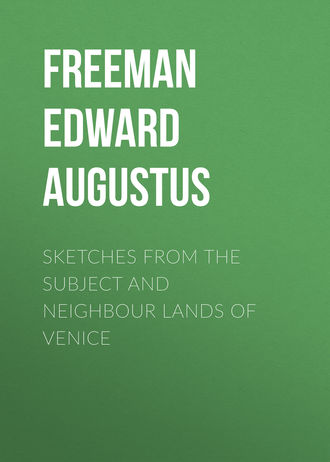
Freeman Edward Augustus
Sketches from the Subject and Neighbour Lands of Venice
Near the north-western corner of the eastern division of the city the foundation of a Christian baptistery has been uncovered. The site of the baptistery, according to all rule, must be near to the site of the great church of the city. Now the baptistery stands near the wall; is it fanciful to think that at Salona, as well as at Rome, it was not thought prudent in the earliest days of the establishment of Christianity to build churches in the more central and prominent parts of the city? The baptistery of Salona keeps – the great basilica must therefore have kept – under the shadow of the wall of the extended city, exactly as the Lateran basilica and baptistery do at Rome. Of the baptistery it is easy to study the plan, as the foundations and the bases of the columns, both of the building itself and the portico in front of it, are plainly to be seen. Many of their splendid capitals are preserved among the rich treasures of the museum at Spalato. These are of a Composite variety, in which the part of the volute is played by griffins, while the lower part of the capital is rich with foliage of a Byzantine type. West of the baptistery, but hardly placed in any relation to it, are the remains of a small church, which seems to have been a square, with columns to the east and an apse to the north. Whatever this building was, it surely can never have been the great church of Salona. That must have been a basilica of the first class; and we may hope that future diggings may bring that to light also. But outside the city to the north, successive diggings have made precious discoveries in the way of Christian burying-places and churches. Since the last researches have been made, it is perfectly clear that here, outside the walls, like the basilicas of the apostles at Rome, there stood a church of considerable size, that it had supplanted a smaller predecessor, and that it had another smaller neighbour hard by. It is now easy – but it is only very lately that it has become easy – to see nearly the whole outline of a church measuring – speaking roughly – about 120 feet long. It ranged therefore with the smaller rather than the larger basilicas of Rome. It had two rows of large columns, which, from their nearness to one another, look as if they had supported an entablature rather than arches, with a transept, with the arch of triumph opening into it, and the apse beyond, to the east. There are also, in front of the arch of triumph, foundations which look most temptingly like those of cancelli, like those of Saint Clement's at Rome, but which seem too narrow for such a purpose. It is also plain, from the base of a smaller column at a lower level, that this comparatively large church was built on the remains of an earlier one. And this is borne out by the discovery of pavements at more than one level, which supported sarcophagi, which are still to be seen, and of which an inscription shows that the lowest level was of the time of Theodosius the Second and Valentinian the Third. This thrusts on the building of the upper and greater church to a later time, surely not earlier than the reign of Justinian. It must therefore have still been almost in its freshness when the last blow fell on Salona. And at such a time we can better take in the full force of the inscription which stood over the west door: "Dominus noster propitius esto reipublicæ Romanæ." The church, it should be noted, has been, at some time or other before it was quite swept away, patched up or applied to some other use. A later wall runs across the western face of the transept. An endless field for guessing is hereby opened; but it is more prudent not to enter upon it.
Another smaller ruined church stands close by, with its apse pointing to the north. This and the eastern part of the larger church are filled with sarcophagi of all kinds and sizes, reminding us of the newly-opened basilica of Saint Petronilla by the Appian Way. Among these is the tomb of an early Chorepiscopus. A crowd of architectural fragments are scattered around, among which one splendid Corinthian capital bears witness to the magnificence of the upper church. But the real wealth of Salona, both sepulchral and architectural, is not to be looked for in Salona itself, but in the museum at Spalato. There are a crowd of superb tombs, pagan and Christian, and the splendid capitals from the baptistery. There are stores of inscriptions, Latin and Greek, which would make the place where they are preserved a place of no small interest, even if that place were not Spalato. But one sarcophagus of pagan date still stays in its place, a little way beyond the city, because, being hewn in the limestone rock, it could not be taken away. This is that which is described by Sir Gardner Wilkinson, which has some of the exploits of Hêraklês carved on its one face, and which has been so oddly changed in modern times into the altar of the canonized Pope Saint Caius. For he, like the Emperor under whom he suffered, passes for a native of Salona. And a no less precious sarcophagus of Christian days is preserved in the cloister of the Franciscan church at Spalato. This represents the crossing of the Red Sea. The Pharaoh looks very much as if he were in a Roman triumphal chariot, trampling a genius or two of the waters under his wheels. His warriors follow, looking, according to the eyes with which we look at them, like Romans in military dress or like Albanians in the immemorial fustanella. The Aryan mind is offended at seeing men of another continent clothed in such a very European garb; it is for Egyptologers to say whether the sculpture is correct. The sea is very narrow; it swallows up the Egyptian chariots with great force, and the rescued Hebrews stand on the other side, Miriam just about to begin her hymn of victory. The subject of the sculpture is obvious; but it seems that nobody understood it till it was expounded by an exalted lady at that royal visit of 1818 which at Spalato is commemorated oftener than enough. The expounder was the wife of the man who had once been the last successor of Diocletian and Augustus; whether his queen had any claim to rank either as a successor of Prisca and Livia or as the doubtful mother-in-law of a conqueror from Ajaccio, we have not looked in any pedigree-book to find out. One would really have thought that the loosing of the knot was so easy that it might have been unravelled by the hand of a subject; but a book which we have before us by a local antiquary goes off into raptures at the surprising keenness of Imperial, Royal, and Apostolic eyes.
The chapel of Saint Caius, with its heathenish altar, brings our thoughts back to the long walls below it, the walls which yoked the ancient Salona to the deeper sea. It must not be forgotten that, in the days of its greatness, Salona was one of the chief ports of the Hadriatic, the greatest on its own side of it. After shifting to and fro from one port to another, that position has come back, if not to Salona itself, yet to its modern representative. If we distinguish the Hadriatic from the Gulf of Trieste, Spalato is undoubtedly its chief port; but the smallness of Spalato, as compared with the greatness of ancient Salona, is a speaking historical lesson. We see the difference between the place in Europe which is held by the Illyrian lands now and the place which they held in the days of the Roman peace. Then Salona was one of the chief cities of the Roman world, placed on one of the most central sites in the Roman world, the chief port of one of the great divisions of the Empire, and one of the main highways between its eastern and western halves. Such could be the position of a Dalmatian city when Dalmatia had a civilized mainland to the back of it. Salona therefore kept up its position as long as the Empire still kept any strength on its Illyrian frontier. It played its part in both the civil wars. Cæsar himself enlarges on the strength of the city – "oppidum et loci natura et colle munitum." In after-times it was a special object of the regard of its own great citizen, who took up his abode so near to its neighbourhood. According to Constantino Porphyrogenitus, Salona was pretty well rebuilt by Diocletian. Its importance went on in the time of transition, as is witnessed by the growth of its ecclesiastical buildings, and by the high position held by its bishopric. Like the rest of the neighbouring lands, it passed under the dominion, first of Odoacer and then of Theodoric, and it was the first place which was won back to the Empire in the wars of Justinian. Lost again and won back again, it appears throughout those wars as the chief point of embarcation for the Imperial armies on their voyages to Italy. This was the last century of its greatness; in the next century the modern history of Illyria begins. The Slaves were moving, and the Avars were moving with them. Salona fell into the hands of these last barbarians; it was ruined and pillaged, and sank to the state in which it has remained till our own time. Since the seventh century Salona has ceased to rank among the cities of the earth, but the house which had been raised by its greatest citizen stood ready hard by to supply a shelter to some at least of its homeless inhabitants. Things were wholly turned about on the bay of Salona and on the neighbouring peninsula. Down to the days of Heraclius, Salona had been a great city, with the vastest house that one man ever reared standing useless in its neighbourhood. From his day onwards the house grew into a city, and the city became a petty village, where, of all the places along that historic coast, the traveller finds least to disturb him in the pious contemplation of ruins. The only danger is that his meditations may be broken in upon by sellers of coins and scraps of all ages, dates, and values. Coins at Salona hardly need the process once known at the Mercian Dorchester as "going a-Cæsaring." Cæsars seem to be picked up from under and off the ground with much less trouble than hunting for truffles. And even he who is no professed numismatist or collector of gems will be pleased to give a few soldi, perhaps even for a very clear image and superscription of "Constantinus Junior Nob[ilissimus] C[æsar]," much more for any image and superscription of Jovius himself. It may have neither rarity nor value in the eyes of the numismatically learned; but it is something to carry away from Salona itself the head of the foremost local worthy in Salona's long annals.
TRAÜ
1875 – 1877 – 1881
The visitor to Spalato and Salona should, if possible, not fail to pay a visit to Traü. To most readers the very name will doubtless be strange. Yet Tragurium is an old city, a city old enough to be named by Polybios, to say nothing of later Greek and Latin writers. As in countless other cases, many readers may have passed by the name without any notice at all; others may have turned to the map, and, having once found Tragurium, may have presently forgotten that Tragurium was anywhere recorded. The case may be different with those who carry on their studies so far as to have dealings with the Imperial topographer. In his pages the name of the city has got lengthened into Τετραγγούριον, and we are told that it was so called διὰ τὸ εἶναι αὐτὸ μικρὸν δίκην ἀγγουρίου. We are not ashamed to confess that the word ἀγγουρίου gave us no meaning whatever, and that we had to turn to our dictionary to find that ἀγγούριον means a water-melon. But where the point of likeness is between the town of Traü and a water-melon, and why the name should have been lengthened, so as to suggest, if anything, the notion of four water-melons, we are as much in the dark as before. Those therefore who have made acquaintance with the city in the shape of Τετραγγούριον will have a chance of keeping it in their minds. But with those who light only either on Tragurium or on Traü, it will most likely happen as most commonly happens with places which play no great part in general history. The name passes away as a mere name, till something happens to clothe it with a special meaning. Salona the parent and Spalato the child are names which never can become meaningless to any one who has a decent knowledge of the history of the world. But the name of Tragurium, Traü, will probably always be purely meaningless, save to those whom anything may have led to take a special interest in Dalmatian matters. Tragurium has a history – no place is without one – but its history is purely local and Dalmatian. As far as one can venture to judge, the great course of human affairs would have been much the same if Tragurium had never become a city. But there it stands, and, as it stands, its position, its buildings, even its local history, combine to give it no small interest. They make it no contemptible appendage even to the famous spots in its immediate neighbourhood. Whatever was its origin, Tragurium became a Roman town, and it was one of those places on the Dalmatian coast which so long and steadily clave to their allegiance to the Eastern Cæsars. As the Byzantine power declined, the town was disputed between the Kings of Hungary and the commonwealth of Venice, and once at least it is said to have felt the hand of Saracen plunderers. By each of the Christian powers by which it was disputed it was won and lost more than once, till it finally became Venetian in 1420. Perhaps the point of greatest interest in these dates is that Traü was a Hungarian possession at the time of the building of its cathedral church in the thirteenth century. It is said to have points of likeness to other great Hungarian churches of the same date.
The approach to Traü is a speaking commentary on the state of things in days when no one but the lord of a private fortress could be safe anywhere except within a walled town. The road from Spalato to Traü goes through Salona, through the heart of the ruined city, as does the railway which the traveller may use for part of his journey. The railway turns off; the road keeps on alongside of the bay, with the water on one side and the mountains on the other. This road passes through the district of the castelli, forts with surrounding villages, which various lords, spiritual and temporal, held of the Serene Republic by a feudal tenure. Things were under the oligarchy of Venice as they were under the democracy of Athens. A private fortress within either city was unheard of; neither Demos nor the Council of Ten would for a moment have endured the existence of such towers as we still see at Rome and at Bologna. But in the outlying possessions of either commonwealth greater licence was allowed. Alkibiadês had his private forts in the Thracian Chersonêsos, and a string of Venetian nobles and subjects of the Republic were allowed to have their private forts along the shores of the bay of Salona. The points which they occupied still remain as small towns and villages, some of them with their little havens on the lake-like sea, where the traveller whom the railway has forsaken may haply light on a small steamer to take him on. But none of those among the castelli which we can ourselves speak of from our own knowledge possess any architectural interest. When at last we reach Traü, we see further how needful it was, even in the case of a walled city, to plant it in the position best suited for defence. Traü, now at least, belongs to the class of island cities. At the point where the large island of Bua comes nearest to the mainland, a small island lies between it and the shore, leaving only a narrow channel on each side, spanned in each case by a bridge. But the language of the Emperor who likens the city to a water-melon might suggest the idea that the site was once, not insular, but peninsular. Constantine places his Τετραγγούριον on a small island, but the small island has a neck like a bridge which joins it to the mainland (μικρόν ἐστι νησίον ἐν τῇ θαλάσσῃ, ἔχον καὶ τράχηλον ἕως τῆς γῆς στενώτατον δίκην γεφυρίου, ἐν ᾧ διέρχονται οἱ κατοικοῦντες ἐς τὸ αὐτὸ κάστρον ). This somewhat contradictory way of speaking sounds as if, as in the case of some other peninsular cities, a narrow isthmus had been cut through. In the Peutinger Table too, "Ragurio" is made distinctly peninsular. Now at least the likeness of a bridge is exchanged for the reality; the island is an island, and on this island is built the main part of the city of Traü. A small part only spreads itself on to Bua, where it begins to climb the hills, though it goes up only a very little way, by paths almost as rugged as though they were in Montenegro. This outlying part, which contains two churches, may pass as a suburb, a Peraia; for Bua may reckon as a mainland when compared with the neighbouring islet, and the real mainland of Dalmatia seems to have been carefully avoided by the builders of Tragurium. The view in Wheler would give no one any idea of the size of Bua, any more than the Peutinger Table would give any idea of its position. But Wheler's view well brings out the relative positions of mainland, islet, and island, and it shows how strongly Traü was fortified in his day. Such a site as this was a valuable one in days when security was the main object; but it hardly tends to prosperity in modern times, and Tragurium must be reckoned among the cities whose day is past. While Spalato is putting on the likeness of a busy modern town, Traü has nothing to show but its ancient memories.
Traü, as we now see it, is indeed an old-world place. Even the new-made railway, which has appeared long since our first visit, and which startles the quiet of Salona and some of the castelli, keeps away from the city of the four water-melons. Strangers come but seldom, and they are remembered when they do come; a visitor showing himself again after some years is greeted in friendly guise as "one of the three Englishmen with red beards." And the city looks like one of the ends of the world. Owing to the peculiar position of Traü, the fashion of narrow streets, common to all the Dalmatian towns, is here carried to an extreme point. Indeed the crooked alleys through which the visitor has to thread his way, and the dark arches and vaults under which he has to pass, give the place a Turkish rather than a Venetian look. The explorer of Traü might almost fancy himself at Trebinje. One wonders how the Tragurians manage to live; it is only on the quay and in the open place by the cathedral that there seems room to breathe. Yet, uninviting as the streets of Traü are in their general effect, they are far from being void of objects of interest. As elsewhere in Dalmatia, we ever and anon light on ornamental doorways and windows. In Traü some of these show better forms than those of the familiar Venetian Gothic; one or two windows are in style, whatever they may be in date, genuine Romanesque. Of the Venetian defences some considerable portions remain; close by the water, at the south-western point of the smaller island, is a castle bearing the badge of Saint Mark, whose chief feature is a tower of irregular octagonal shape, singularly and ingeniously vaulted within. Of civic buildings the chief is the Venetian loggia, now dirty and uncared for. But it still keeps at its east end what at first sight seems like an altar, dedicated, not to the Evangelist but to his lion, but which really marks the judgment-seat of the representative of the Republic in Traü. The building was repaired over and over again, the last renovation dating early in the seventeenth century; but it keeps a colonnade, which, whenever it was put together, was put together out of materials of far earlier date. Some of the capitals seem to be late; but there is one of true Corinthian form, which seems closely akin to those in Diocletian's peristyle; another capital is covered with rich foliage of a type rather Byzantine than classical. And on either side of the loggia, forming a strange contrast to one another, one of them utterly hidden from view, the other proclaiming itself as the main ornament of the town, stand the two most important ecclesiastical buildings of Traü.

CATHEDRAL, TRAÜ.
The chief architectural ornament of the city is undoubtedly the formerly cathedral, now only collegiate, church. This is a work of the thirteenth century, with a stately bell-tower of the fourteenth or fifteenth. But the tower of Traü is no detached campanile, such as we have seen at Zara and Spalato. It forms part of the building; it occupies its north-western corner, and was designed to be one of a pair, after the usage of more northern lands. The inscription on the southern doorway gives 1215 as its date; one on the great western doorway names 1240, and adds the name of Raduanus as its artist. Looked at from the outside, the work is of the best and most finished kind of Italian Romanesque; and we have here, what is by no means uncommon in Dalmatia, an example of the late retention of the forms of that admirable style. The tower palpably belongs to a later date, as it shows the distinct forms of the Venetian Gothic, though, as usual in Dalmatia, in a not unpleasing form. Eitelberger quotes an inscription which gives the date as 1321, while in his text he speaks of it as 1421, just after the Venetian capture of the town. And the course of Dalmatian architecture is so capricious, forms are found at dates when one would so little have looked for them, that we really cannot undertake to decide between the two. The inside of the church is striking, with its round arches resting on massive square piers of German rather than Italian character, and with its clerestory and vault, in which the round and pointed arch are struggling for the mastery. By a freak almost more unaccountable than the red rags of Zara, the piers have very lately been taught to discharge the perhaps useful, but rather incongruous, function of a catalogue of the bishops of Traü, bishops whose succession has come to an end. The pulpit, the stalls, and other fittings, are also striking in many ways, and the triapsidal east end shows us a rather simple Romanesque style in all its purity. But the glory of Traü is at the other end. The stately portico veils the still more stately western doorway, in which, if the purity of the architectural style is somewhat forsaken, we forgive it for the richness and variety of its sculpture. The scriptural scenes in the tympanum, the animal forms, the statues of Adam and Eve, the crouching turbaned figures, the strange blending together of sculpture and architectural forms, make together a wonderful whole, none the less wonderful because it is clear that everything is not exactly in its right place, but that there has been a change or removal of some kind at some time. The details of this splendid doorway, and of the church in general, must be studied in the elaborate memoir of Eitelberger, which, with its illustrations, goes further than most memoirs of the kind to make the building really intelligible at a distance. The turbaned figures are far older than the appearance of the Ottoman in the neighbourhood of Traü, or indeed in any part of Europe. Are they Saracens whose forms record the memories of some returning Crusader? Or are we to believe that the Morlacchi used the turban as their head-dress before the Ottoman came?
But the duomo is not all that Traü has to show in the way of churches. On the other side of the Venetian loggia stands, hidden among other buildings, a church which is in its way of equal interest with its greater neighbour, which certainly shows us a purer form of Romanesque. This is the little desecrated church of Saint Martin, now called Saint Barbara, one of those domical buildings on a small scale of which we have seen other varieties at Zara and at Spalato. Its height and the tall stilts on its columns would, if the building were cleared out, make it one of the most striking instances of its style and scale. Nearer to the water, south-east from the cathedral, is another small Romanesque church, almost as striking without as Saint Barbara is within. This is the small church of Saint John Baptist, which, except that it has a square east end, might pass for an almost typical Romanesque church on a small scale. Nearly opposite to Saint Barbara is the most striking house in Traü, with an open galleried court; and not very far off, hidden in the narrow streets, is the Benedictine monastery of Saint Nicolas, the foundation of the local saint John Orsini in 1064. The points to be noticed are not in the church but in the adjoining buildings. There, besides some pretty Venetian windows and doorways, is an arcade which looks as if it were of genuine Romanesque date, though perhaps hardly so old as the saint himself. A walk outside the walls in the direction of the Venetian castle leads to other churches, one of which, attached to a house of Dominican nuns, surprises the visitor, like the ruined chapel of the Gaetani by the tomb of Cæcilia Metella, by its almost English look. A few hours may well be spent in examining the antiquities of this strange little island city, and in taking in the varied views of land and sea which are to be had alike from the lofty bell-tower and from the higher ground on Bua. The journey back again shows us objects which have become familiar to us, but which are now seen in a reverse order. We mark the ever shifting outlines of the hills, the islands and the bay which they surround, the ruins of fallen Salona, Clissa on its peak, the stream of Giadro, the aqueduct of Diocletian, till we again mount and descend the little hill on the neck of the isthmus, and find ourselves once more under the shadow of the palace-walls of Spalato and of the bell-tower which soars so proudly over them.

SAINT JOHN BAPTIST, TRAÜ.







